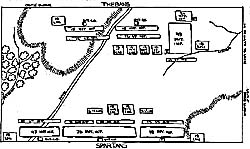Historical Background:
The elation over the fall of Athens in 404 B.C. and the lifting of her despotism has withered. A new power, Sparta, has assumed the role of Athens as oppressor of the city states. Yet, from the city-state of Thebes in Boiotia, central Greece, there is a glimmer of hope, his name is Epameinondas. It is he who will conceive a revolution in tactics that will end the Spartan myth on the field of battle.
The scene is set as treaty negotiations break down and the Spartan King, Kleombrotos leads a numerically superior army towards Thebes. In the Spartan camp there is an arrogance and confidence, which showed itself in an impatient eagerness to begin the conflict and secure the victory. Yet, Kleombrotos seems to have hung back, perhaps secretely wishing to give the Thebans a chance of escaping or surrendering. Now, after the noonday mean Kleombrotos drew up his army twelve deep, posting himself and most of the Spartans on the right.
Epameinondas, a philosophical tactician, had studied all the recent improvements in the art of war, and the weak points of the old system. He noted that the strength of the Spartan phalanx lay in it's disciplined cohesion, it's weakness in its inability to meet new threats. But the tactics of Epameinondas in drawing up his troops were no less skillful than his means for inspiring them with courage. He first weeded his ranks of all who were fearful and afraid by proclamation that all those who wished might depart. Next, he formed his Theban battle line in echelon with his leftwing consisting of a compact column fifty deep, and the Sacred Band under Pelopidas.
The battle began with a cavalry charge by each side and the Spartan squadrons, notoriously inefficient, were swept back in confusion upon their main body. Kleombrotos, according to acknowledged principles of Greek warfare, at once ordered his infantry to advance along the whole line.
As they advanced, the right met the mass of the Theban left, the shock was terrible. The Theban column wedged itself into every opening in the enemy's ranks, which the recoil of the cavalry had perhaps thrown into some disorder. The Spartan king had originally proposed to use his superiority in numbers to surround Epameinondas or at least to turn his flank. but the movements of Pelopidas and the Sacred Band had been so rapid that they were upon him before he could deploy his troops. Nothing there fore remained for the Spartans but to bear up, shield to shield, against the mass that bore down upon them. In the fierce hand-to-hand combat which ensued, the king was struck with a mortal wound.
Epameinondas urged his men on to a crowning effort, and at length, the weaker line of wearied Spartans broke. Apparently, in no other part of the line had there been any real fighting, for the Theban center and right had been purposely kept back. But, seeing the discomfort of their friends, the whole line fell back, and formed in good order behind the entrenchment of their camp, and the Thebans did not attempt to press the pursuit.
Seeing how large a portion of the Spartans had fallen, and observing the lukewarm and spiritless temper of some of their allies, a herald was dispatched to ask for the burial truce. Epameinondas granted the truce but stipulated that the corpses of the allies should be buried before those of the Spartans. This made it impossible for the Spartans to conceal the severity of their losses
Wargaming The Battle of Leuktra
Rules: Ancient Miniature Rules
Special Rules:
Thebans
-
1. The massed column is +1 for every rank over four while in melee contact.
2. Epameinondas-morale: Within 10" = +2 Attached = +3
3. Pelopedas-morale = army C.O. rate
4. The Sacred Band may make one non-charge forced march of 9".
Spartans
- 1. Phalanx formation - no more than tour ranks deep.
2. Phalanx movement - four inches per turn, charge of seven inches.
Back to MWAN #18 Table of Contents
Back to MWAN List of Issues
Back to Master Magazine List
© Copyright 1985 Hal Thinglum
This article appears in MagWeb (Magazine Web) on the Internet World Wide Web.
Other military history articles and gaming articles are available at http://www.magweb.com
